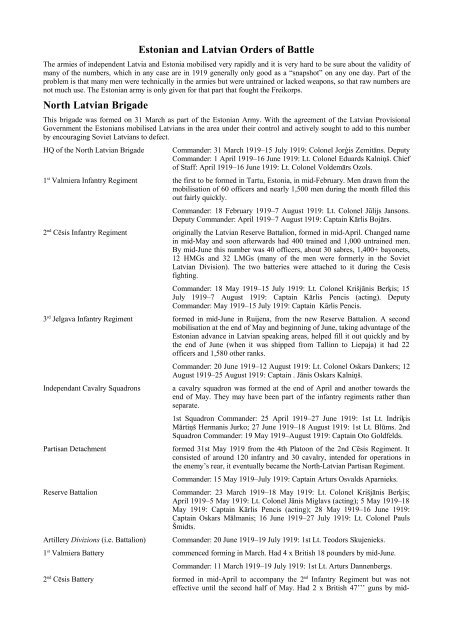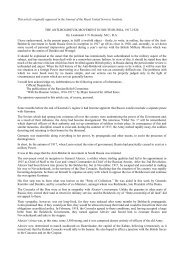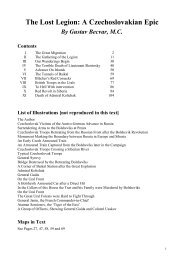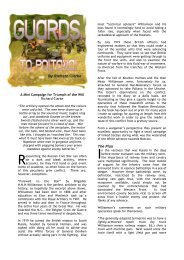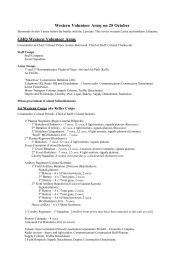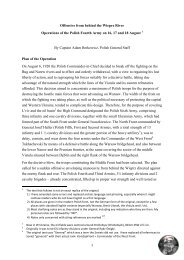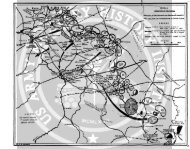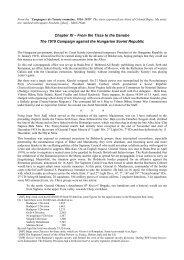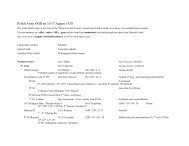Nationalist Order of Battle at CÄsis - Pygmy Wars Home
Nationalist Order of Battle at CÄsis - Pygmy Wars Home
Nationalist Order of Battle at CÄsis - Pygmy Wars Home
- No tags were found...
You also want an ePaper? Increase the reach of your titles
YUMPU automatically turns print PDFs into web optimized ePapers that Google loves.
Estonian and L<strong>at</strong>vian <strong>Order</strong>s <strong>of</strong> <strong>B<strong>at</strong>tle</strong>The armies <strong>of</strong> independent L<strong>at</strong>via and Estonia mobilised very rapidly and it is very hard to be sure about the validity <strong>of</strong>many <strong>of</strong> the numbers, which in any case are in 1919 generally only good as a “snapshot” on any one day. Part <strong>of</strong> theproblem is th<strong>at</strong> many men were technically in the armies but were untrained or lacked weapons, so th<strong>at</strong> raw numbers arenot much use. The Estonian army is only given for th<strong>at</strong> part th<strong>at</strong> fought the Freikorps.North L<strong>at</strong>vian BrigadeThis brigade was formed on 31 March as part <strong>of</strong> the Estonian Army. With the agreement <strong>of</strong> the L<strong>at</strong>vian ProvisionalGovernment the Estonians mobilised L<strong>at</strong>vians in the area under their control and actively sought to add to this numberby encouraging Soviet L<strong>at</strong>vians to defect.HQ <strong>of</strong> the North L<strong>at</strong>vian BrigadeCommander: 31 March 1919–15 July 1919: Colonel Jorģis Zemitāns. DeputyCommander: 1 April 1919–16 June 1919: Lt. Colonel Eduards Kalniņš. Chief<strong>of</strong> Staff: April 1919–16 June 1919: Lt. Colonel Voldemārs Ozols.1 st Valmiera Infantry Regiment the first to be formed in Tartu, Estonia, in mid-February. Men drawn from themobilis<strong>at</strong>ion <strong>of</strong> 60 <strong>of</strong>ficers and nearly 1,500 men during the month filled thisout fairly quickly.Commander: 18 February 1919–7 August 1919: Lt. Colonel Jūlijs Jansons.Deputy Commander: April 1919–7 August 1919: Captain Kārlis Bojārs.2 nd Cēsis Infantry Regiment originally the L<strong>at</strong>vian Reserve B<strong>at</strong>talion, formed in mid-April. Changed namein mid-May and soon afterwards had 400 trained and 1,000 untrained men.By mid-June this number was 40 <strong>of</strong>ficers, about 30 sabres, 1,400+ bayonets,12 HMGs and 32 LMGs (many <strong>of</strong> the men were formerly in the SovietL<strong>at</strong>vian Division). The two b<strong>at</strong>teries were <strong>at</strong>tached to it during the Cesisfighting.Commander: 18 May 1919–15 July 1919: Lt. Colonel Krišjānis Berķis; 15July 1919–7 August 1919: Captain Kārlis Pencis (acting). DeputyCommander: May 1919–15 July 1919: Captain Kārlis Pencis.3 rd Jelgava Infantry Regiment formed in mid-June in Ruijena, from the new Reserve B<strong>at</strong>talion. A secondmobilis<strong>at</strong>ion <strong>at</strong> the end <strong>of</strong> May and beginning <strong>of</strong> June, taking advantage <strong>of</strong> theEstonian advance in L<strong>at</strong>vian speaking areas, helped fill it out quickly and bythe end <strong>of</strong> June (when it was shipped from Tallinn to Liepaja) it had 22<strong>of</strong>ficers and 1,580 other ranks.Independant Cavalry SquadronsPartisan DetachmentReserve B<strong>at</strong>talionArtillery Divizions (i.e. B<strong>at</strong>talion)Commander: 20 June 1919–12 August 1919: Lt. Colonel Oskars Dankers; 12August 1919–25 August 1919: Captain . Jānis Oskars Kalniņš.a cavalry squadron was formed <strong>at</strong> the end <strong>of</strong> April and another towards theend <strong>of</strong> May. They may have been part <strong>of</strong> the infantry regiments r<strong>at</strong>her thansepar<strong>at</strong>e.1st Squadron Commander: 25 April 1919–27 June 1919: 1st Lt. IndriķisMārtiņš Hermanis Jurko; 27 June 1919–18 August 1919: 1st Lt. Blūms. 2ndSquadron Commander: 19 May 1919–August 1919: Captain Oto Goldfelds.formed 31st May 1919 from the 4th Pl<strong>at</strong>oon <strong>of</strong> the 2nd Cēsis Regiment. Itconsisted <strong>of</strong> around 120 infantry and 30 cavalry, intended for oper<strong>at</strong>ions inthe enemy’s rear, it eventually became the North-L<strong>at</strong>vian Partisan Regiment.Commander: 15 May 1919–July 1919: Captain Arturs Osvalds Aparnieks.Commander: 23 March 1919–18 May 1919: Lt. Colonel Krišjānis Berķis;April 1919–5 May 1919: Lt. Colonel Jānis Miglavs (acting); 5 May 1919–18May 1919: Captain Kārlis Pencis (acting); 28 May 1919–16 June 1919:Captain Oskars Mālmanis; 16 June 1919–27 July 1919: Lt. Colonel PaulsŠmidts.Commander: 20 June 1919–19 July 1919: 1st Lt. Teodors Skujenieks.1 st Valmiera B<strong>at</strong>tery commenced forming in March. Had 4 x British 18 pounders by mid-June.Commander: 11 March 1919–19 July 1919: 1st Lt. Arturs Dannenbergs.2 nd Cēsis B<strong>at</strong>tery formed in mid-April to accompany the 2 nd Infantry Regiment but was noteffective until the second half <strong>of</strong> May. Had 2 x British 47’’’ guns by mid-
June.Commander: April 1919–23 May 1919: 1st Lt. Teodors Skujenieks (acting);23 May 1919–20 June 1919: 1st Lt. Teodors Skujenieks; 20 June 1919–23September 1919: 1st Lt. Visvaldis Dūms.3 rd Rūjiena B<strong>at</strong>tery started forming in mid-June and did not receive its guns until l<strong>at</strong>er.Commander: 20 June 1919–August 1919: 1st Lt. Voldemārs Johans Šēnfelds.At the end <strong>of</strong> June the Brigade had 223 <strong>of</strong>ficers, 26 military <strong>of</strong>ficials and 9,554 other ranks.The structure mirrored th<strong>at</strong> <strong>of</strong> the Estonian army, so each regiment was three b<strong>at</strong>talions <strong>of</strong> four companies, supposedly158 men each, and sapper, foot scouts, horse scouts and signals detachments.I would guess from these numbers th<strong>at</strong> each infantry regiment was some 1,600 men <strong>at</strong> the time <strong>of</strong> the Cesis fighting,many <strong>of</strong> whom would have little training and less equipment.Balodis BrigadeOn 5 June, the Estonians believed th<strong>at</strong> the Balodis Brigade was 333 <strong>of</strong>ficers, 360 junior <strong>of</strong>ficers, 1,500 bayonets, 120sabres, 20 HMGs, 444 LMGs.Estonian ArmyFirst <strong>B<strong>at</strong>tle</strong>s for Cesis – early JuneIn May 1919 the Estonians had their 2 nd and 3 rd Divisions on their southern front, the 1 st being on the Narva front. The2 nd Division was facing mainly towards Pskov, with the 3 rd Division to their west facing the L<strong>at</strong>Div. It was therefore the3 rd Division th<strong>at</strong> first ran into the Landeswehr. It contained <strong>at</strong> this time the 3 rd , 6 th and 9 th Infantry Regiments and theTallinn Independent Squadron (<strong>at</strong>tached to the 6 th Regt.), being 5,200 bayonets and sabres, 120 MGs, 17 artillery pieces,2 armoured cars and 1 train (Broad Guage #4). The L<strong>at</strong>vian 2 nd Cesis Regiment was soon added to their roster, and BGtrains #2 and #5 arrived.The 1 st Red L<strong>at</strong>vian Rifle Division which had been opposing them was estim<strong>at</strong>ed <strong>at</strong> 7,100 bayonets and sabres, 127MGs, 25 artillery pieces and 1 armoured train.Second <strong>B<strong>at</strong>tle</strong>s for Cesis – l<strong>at</strong>e June.3 rd Division3 rd Regiment:1 st B<strong>at</strong>talion:1 st to 4 th Companies.2 nd B<strong>at</strong>talion:5 th to 8 th Companies.3 rd B<strong>at</strong>talion:9 th to 12 th Companies.Foot Scouts Detachment. May have been <strong>at</strong>tached to 2 nd B<strong>at</strong>talion.Horse Scouts Detachment.Tallinn Independent Squadron – 65 sabres, ? MGs. Formerly <strong>at</strong>tached to the 6 th Regiment.3 rd B<strong>at</strong>tery, 3 rd Arty Rgt – 2 x 6" Schneider howitzers1 st Pl<strong>at</strong>oon, 4 th B<strong>at</strong>tery, 3 rd Arty Rgt – 2 x British 18 poundersThe regiment numbered about 50 <strong>of</strong>ficers, 1,241 bayonets, 18 sabres, 14 LMGs, 17 HMGs. It had someobsolete mortars as well.6 th Regiment:1 st B<strong>at</strong>talion:1 st Coy – 105 bayonets, 1 LMG;2 nd Coy – 114 bayonets, 2 LMGs;3 rd Coy – 114 bayonets, 1 LMG;4 th Coy – 80 bayonets, 1 LMG;Attached 2 MG pl<strong>at</strong>oons from MG Company.2nd B<strong>at</strong>talion:5 th Coy – 179 bayonets;6 th Coy – 139 bayonets, 2 LMGs;7 th Coy – 163 bayonets;
8 th Coy – 167 bayonets;B<strong>at</strong>talion MG Company – 130 men, 4 HMGs and 6 LMGs. One pl<strong>at</strong>oon per company.3 rd B<strong>at</strong>talion:10 th Coy – 92 bayonets;11 th Coy – 95 bayonets, 1 LMG;pl<strong>at</strong>oon <strong>of</strong> the 12 th Coy – 38 bayonets; The rest <strong>of</strong> this company was <strong>at</strong>tached to NG Train #4.Foot Scouts Detachment – 63 bayonets, 1 LMG;Attached MG pl<strong>at</strong>oon from MG Company.4 th B<strong>at</strong>talion:13 th Coy – 44 bayonets;14 th Coy – 136 bayonets, 1 LMG;15 th Coy – 60 bayonets; Mostly composed <strong>of</strong> Russians.1 st Company <strong>of</strong> the Viljandi-Pärnu Pupils B<strong>at</strong>talion – 105 bayonets, 2 LMGs.Attached MG pl<strong>at</strong>oon from MG Company.Regimental MG Company – 140 men, 7 HMGs, 8 LMGs; 4 equal pl<strong>at</strong>oons shared out, as above.6 th B<strong>at</strong>tery, 3 rd Arty Rgt – 4 x British 18 pounders; One gun appears to have been out <strong>of</strong> order for the b<strong>at</strong>tle.1 st B<strong>at</strong>tery, 3 rd Arty Rgt – 2 x 6" Schneider howitzers;Sapper Detachment – 23 bayonets.Horse Scouts Detachment – 29 sabres, 1 LMG. Missing 17 men, detached as orderlies to the b<strong>at</strong>talions.Signals Detachment – 43 men.Labour Company – 273 men.Staff Detachment – 43 men.Commandant Detachment – 17 men.Orchestra – 43 men.Attached Armoured car “Vanapagan” – 2 LMGs.Attached NG Train #4 Landing Company – 63 bayonets, 2 LMGs.Attached Captain Plan-Dubrovsky’s L<strong>at</strong>vian Cavalry Squadron – 75 sabres. Ex-Balodis Brigade.Attached Cesis Pupils Company (L<strong>at</strong>vians) – 40 bayonets, 3 HMGs, 2 LMGs.With 61 <strong>of</strong>ficers (including doctors and cadets), 1,987 bayonets, 46 sabres, 6 guns, 11 HMGs, 27 LMGs,86 signals men and 376 rear service men this was the largest regiment in the Estonian army <strong>at</strong> the time(the numbers exclude <strong>at</strong>tached troops).9 th Regiment:1 st B<strong>at</strong>talion:1 st to 4 th Companies – each perhaps 80 men, 1 or 2 LMGs.2 nd B<strong>at</strong>talion:5 th Coy – 106 bayonets, 1 HMG, 1 LMG;6 th Coy – 157 bayonets 2 LMGs;7 th Coy – 116 bayonets, 2 LMGs;8 th Coy – 110 bayonets, 1 LMG.Foot Scouts Detachment – ~60 men.B<strong>at</strong>tery – 2 x Russian 57 mm, 2 x Russian model 1895 88mm guns.Machine Gun Company – 2 HMGs, about 6 LMGs.Signals Detachment.Training Company.Labour Company.Orchestra.Attached Vidriži local L<strong>at</strong>vian commandant – ~50 men.Attached 2 nd Pl<strong>at</strong>oon, 4 th B<strong>at</strong>tery, 3 rd Arty Rgt – 2 x British 18 pounders.Strength in mid-June was in the region <strong>of</strong> 26 <strong>of</strong>ficers and 932 bayonets (perhaps 1,800 men total). Thiswas not a top regiment, containing a lot <strong>of</strong> very young or old men, although the 6 th Company, <strong>at</strong> least,was considered reasonably trained and disciplined. The artillery was worn out, lacked fire correctioninstruments and only the commander was a trained artillerist. The ammunition supply was 180 – 200bullets per rifleman, about 3,000 bullets per HMG and 1,000–1,600 bullets per LMG.BG train #2 – 8 LMGs, 15 HMGs and 4 guns, probably 2 x 3.62mm Russian guns, one 75 mm naval gun and a130 mm Vickers naval gun The Landing B<strong>at</strong>talion had 130 bayonets.BG train #3 – 16 HMGs, 8 LMGs and 3 guns, probably 2 x 3.62mm Russian guns and 1 x 75mm AA from aBritish warship. The Landing B<strong>at</strong>talion was 171 bayonets (landing b<strong>at</strong>talions took their MGs fromthe trains complement).BG train “Kapten Irv” – 17 HMGs, 6 LMGs and probably 2 x 3.62mm Russian guns. The Landing B<strong>at</strong>talion was195 bayonets.(BG train #5 had gone to Pskov.)
2 nd Division:This division was ordered to send a few elements to assist, but failed to send them all. Only those th<strong>at</strong> actuallyarrived are noted below.Kuperjanov Partisan B<strong>at</strong>talion:4 companies;MG detachment;Signals detachment;Scouts detachment;Attached 2 nd B<strong>at</strong>tery, 3 rd Arty Regt – 2 x 6” Vickers howitzers, 2 x 7.62mm Russian guns.This unit had been filled out with drafted men, so had lost some <strong>of</strong> its partisan character. It was around19 <strong>of</strong>ficers, 395 bayonets, 6 HMGs and 10 LMGs. It had been part <strong>of</strong> the Armoured Train Divizion<strong>at</strong>tached to the 2 nd Division.“Kalevlaste Maleva” B<strong>at</strong>talion:4 companies;MG detachment;Signals detachment;Foot Scout Detachment;Originally formed from the “Kalev” sports society, it had been filled out with the draft. It had 316bayonets, 7 LMGs, 6 HMGs. The 4 th Company, <strong>of</strong> 98 men, was only added on about 21 June. It had beenpart <strong>of</strong> the Armoured Train Divizion <strong>at</strong>tached to the 2 nd Division.Armoured cars “Estonia” and “Toonela” – each 1 HMG, 2 LMGs, 1 x 37 mm gun.(The “Vanapagan” had 2 MGs).1 st Division:1 st Inf Regiment:Regimental HQ and Command Detachment;2 nd B<strong>at</strong>talion;MG Company;Bomb Thrower Detachment. Not mortars, but grenadiers.The strength sent to the southern front was 504 bayonets, 14 LMGs, 4 HMGs total.1 st B<strong>at</strong>tery, 1 st Artillery Regiment – 4 x British 18 pounders.2 nd Cavalry Regiment4 horse squadrons;1 foot squadron;MG squadron;Strength was 171 bayonets, 399 sabres, 19 MGs.There were also various reserve b<strong>at</strong>talions to the rear – the 3 rd Division and Armoured Train Divizion each hadthree – such as the Võrumaa Defence B<strong>at</strong>talion – 272 bayonets, 3 HMGs, 4 LMGs, 4 light guns.A B.E.2e plane was also sent, but was shot down by a sentry who had not been informed it was coming.Notes:The number <strong>of</strong> machine-guns given above are probably underst<strong>at</strong>ed, since units did not count any captured weapons, soas to prevent them being taken away and given to other units.In the l<strong>at</strong>er fighting around Cesis the Estonians had 11 mortars.The Estonian Army in June 1919The bulk <strong>of</strong> Estonian soldiers were aged between 17 and 36.At this time the Estonians lacked many <strong>of</strong> the military essentials. Uniforms were a mixture <strong>of</strong> Russian, British andEstonian, with a fair mix <strong>of</strong> men in civilian clothing too – it was only in July th<strong>at</strong> the British uniforms started to arrive indecent quantities. Decent footwear was lacking, but this was not so important in summer. Few men had cartridgepouches and knapsacks were similarly lacking, which resulted in pockets full <strong>of</strong> ammunition and carts full <strong>of</strong> belongingstying up the rear.Rifles were <strong>of</strong> many different types, but mainly ex-Russian, with about 30% Japanese and a few German. Hand grenades
were in short supply but enough <strong>of</strong> bullets.HMGs were mostly Russian Maxims, but there were also German Maxims and Colts. The LMGs were mostly Madsens,with some Lewises and Bergmans.Artillery pieces were old and lacked optical equipment. Although the new British guns were coming through, itundoubtedly took some time to learn them (the ranging system was completely different on British and Russian guns).There was a shortage <strong>of</strong> ammunition caissons and the carts used as replacements were less suited to cross-countrymanoeuvres but no particular shortage <strong>of</strong> ammunition.There were shortages <strong>of</strong> signals equipment, and the civilian telephone lines were used as much as possible. Maps were<strong>of</strong>ten in short supply, and company commanders were frequently without them.As in all the Baltic, medical supplies were in very short supply.Estonian NavyIn the L<strong>at</strong>vian oper<strong>at</strong>ions:Lennuk Destroyer 5 x 102mm, 1 x 37mmWambola Destroyer 4 x 102mm, 1 x 37mmLembit Gunbo<strong>at</strong> 2 x 120mm, 4 x 75mm, 1 x 37mmTasuja Gunbo<strong>at</strong> 1 x 130mm, 2 x 75mmKalev Minesweeper 1 x 37mmOlev Minesweeper 1 x 37mm


